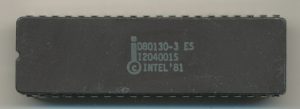When Intel Runs out of Chips…..
A seemingly impossible occurrence today, but something that Intel has faced in the past. It is common for customers to need chips that are no longer in production, either for repair of legacy systems, or to keep an old but reliable design in production. Typically these parts can be sourced on the secondary market, or from End-of-Life suppliers such as REI, or InnovASIC. But what happens when Intel themselves needs a chip that they previously made, but no longer do?
Such was the case with the 80130 Operating System Processor. The 80130 was a co-processor designed in 1981, to make use of Intel’s high-density ROM capabilities. The 80130 contained 16K of ROM, 3 timers (compatible with 8254), an interrupt controller (similar to the 8259), and a baud-rate generator. It was capable of bus management and control and could directly control an 8087 FPU as well. These are designed to work with the 8086/88 and 80186/188 processors. The 16K of ROM was coded with 35 Operating System primitives (a subset actually of the Intel iRMX86 RTOS (Real Time Operating System). This firmware allowed easier support for the constructs typically used in a multitasking OS. Essentially the 80130 extended the instruction set of the x86 to include higher level OS functions.

Intel D80130-2 – 1983 – Production version (though datasheets continued to be marked ‘Preliminary’ though its entire life)
The original version, called (for no known reason) the 80130-3 was released in engineering sample versions only. It could run at up to 8MHz allowing it to work with any of the x86 processors of the time. After some small timing adjustments, the 80130 was released to production as the 80130-2, still keeping with the 8MHz max. Later references show a 80130 at 5MHz as well as the 8MHz -2 part. However, the 5MHz part has not been seen (as of this writing) and is likely to exist only in datasheets.
Posted in:
CPU of the Day


